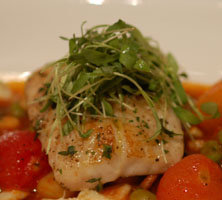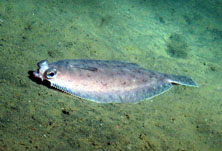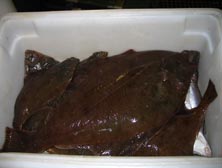Dover Sole (Microstomus pacificus)
- Dover sole population levels are high and no overfishing is occurring.
- Federal fisheries management measures have reduced the number of vessels fishing in the Dover sole fishery, resulting in greater conservation and improved economic benefits to the fishery.
- Dover sole is an excellent source of low-fat protein, calcium, and other important nutrients. For more information, please see Nutrition Facts. (USDA)
-
Over 13.5 million pounds of Dover sole were landed in 2006 at a value of $5 million.
|
 |
 |
 |
 |
| Nutrition Facts |
| Servings 1 |
| Serving Weight
100g |
 |
| Amount Per Serving |
 |
| Calories 91 |
 |
| Total Fat |
1.19 g |
 |
| Total Saturated Fatty Acids |
0.283 g |
 |
| Carbohydrate |
0 g |
| Sugars |
0 g |
| Total Dietary
Fiber |
0 g |
 |
| Cholesterol |
48 mg |
 |
| Selenium |
32.7 mcg |
 |
| Sodium |
81 mg |
 |
| Protein |
18.84 g |
 |
|
 |
 Dover sole is a flatfish, like a flounder. Both of its eyes lie on one side of its head. Dover sole is a flatfish, like a flounder. Both of its eyes lie on one side of its head.
|
 |
Did you know?
Larval Dover sole can apparently delay metamorphosis to the benthic juvenile stage and can thus have incredibly long larval stages, as long as 1 or 2 years. This is certainly one of (if not the) longest larval durations for any flatfish species.
Juvenile and adult Dover sole excrete copious amounts of mucous (i.e., slime) onto their skin/scales, making them incredibly slippery and hard to pick up or hold. The slime may cover other fishes when they are caught in trawls.
|
|
| |
 |
|
A Dover sole lies on the muddy seafloor. The sole's color helps the fish camouflage itself on the seafloor.
|
 |
|
Dover sole collected during the 2005 Gulf of Alaska Groundfish Survey. Since Dover sole excrete slime onto their skin/scales, researchers have reported that it is difficult to get a hold on the fish in order to measure it.
|
|
Sustainability Status
Biomass: Pacific coast Dover sole biomass was estimated to be 189,000 metric tons in 2005, 1.6 times the target biomass. Gulf of Alaska biomass is 135% above the biomass needed to support maximum sustainable yield.
Overfishing: No
Overfished:No
Fishing and habitat: Bottom trawls are used to catch Dover sole on soft bottoms off the Pacific coast and Gulf of Alaska. Because the species inhabiting soft bottom communities are frequently fast growing and short-lived, these communities may be more resilient to trawling impacts than other habitats. The Alaska Fisheries Science Center's Auke Bay Laboratory and Resource Assessment and Conservation Engineering Division are currently conducting studies on the effects of bottom trawling on habitat.
Bycatch: In Alaska, across the entire flatfish fishery, grenadiers and large sculpins sustained the highest bycatch in 2005. Small amounts of prohibited species such as halibut and crab are also taken in the Dover sole-directed fishery. Off the Pacific coast, Dover sole are mostly caught as part of a deepwater complex that includes sablefish and two species of thornyhead rockfish.
Aquaculture: There is currently no aquaculture production of Dover sole in the United States, although there has been increasing interest in culturing flatfish in general.
|
Science and Management
Off the Pacific coast, Dover sole support a high-value commercial fishery but are not important recreationally. The fishery is managed through the Pacific Fishery Management Council's Groundfish Fishery Management Plan. All sectors of the groundfish fishery are currently constrained by the need to rebuild other groundfish species that have been declared overfished. Groundfish are managed through a number of measures, including harvest guidelines, quotas, trip and landing limits, area restrictions, seasonal closures, and gear restrictions (such as minimum mesh size for nets). In 1994, Amendment 6 to the Groundfish FMP set up a limited entry program for the fishery. In 2003, NOAA's National Marine Fisheries Service (NMFS) implemented a vessel buyback program to reduce the number of vessels and permits in the Pacific coast groundfish trawl fishery in order to increase productivity, financially stabilize the fishery, and conserve and manage fish.
In the Gulf of Alaska, the Dover sole fishery is managed by the North Pacific Fishery Management Council (NPFMC) through the Gulf of Alaska Groundfish Fishery Management Plan (FMP), which was first implemented December 1, 1978, and has since been amended over 60 times. This FMP governs groundfish fisheries in the portion of the Gulf of Alaska within the U.S. EEZ (3 to 200 miles offshore). Dover sole is managed as part of the "deep water flatfish group" along with Greenland turbot and deep-sea sole, but the fishery primarily targets Dover sole. The NPFMC sets an annual Total Allowable Catch (TAC) for the fishery and has continually set conservative quotas, allowing for sustained yields for the past 10 years. Since 1990, NPFMC has recommended that all catch be allotted to the domestic fishery, so the groundfish fishery has been wholly U.S.-processed since then. In 1996, NPFMC established a moratorium on entry of new vessels into the groundfish fishery to prevent the "race for fish," which results from the combination of short seasons, a large number of vessels, and a limited resource to fish. A license limitation program was approved in 1997 to take the place of the moratorium; this program limits the number, size, and specific operation of vessels in groundfish fisheries.
The Alaska Fisheries Science Center Resource Assessment and Conservation Engineering Division (RACE) surveys Dover sole in the Gulf of Alaska every 2 years. Off the Pacific coast the Northwest Fisheries Science Center - Fishery Resource Analysis and Monitoring Division (FRAM) conducts annual bottom trawl surveys that collect data on Dover sole biomass and size and age composition.
|
Life History and Habitat
Life history, including information on the habitat, growth, feeding, and reproduction of a species, is important because it affects how a fishery is managed.
- Geographic range: From the Bering Sea and western Aleutian Islands to southern Baja California.
- Habitat: Dover sole are demersal, meaning they live close to the bottom. They are found on soft bottoms at depths from 7 feet to about 4,500 feet.
- Life span: Females can live up to 53 years, and males can live up to 58 years.
- Food: Dover sole feed during the daytime by sight and smell on small invertebrates that live on or in seafloor sediments. Their small mouths are well adapted for feeding on small invertebrates (such as polychaete worms and clams) that live within the sediment and consume detritus or ones that live at the sediment surface, such as amphipods and other small crustaceans, shrimp, snails, and brittlestars. Larval Dover sole specifically eat copepods (small crustaceans), eggs, and nauplii (larval crustaceans), as well as other plankton (tiny drifting plants and animals). Juveniles and adults feed on polychaete worms, bivalves, brittlestars, and small benthic crustaceans.
- Growth rate: Females grow faster and to larger sizes than males.
- Maximum size: Females grow to a maximum length of 2 feet 6 inches, about 2 to 4 inches longer than males.
- Reaches reproductive maturity: The average age of females at maturity is 7 years, and their average length is 1 foot.
- Reproduction: Dover sole are batch spawners, meaning they spawn multiple times in a single spawning season. A 1.4-foot female has about 52,000 eggs, and a 1.9-foot female can have 266,000 eggs. Eggs are epipelagic and found in the upper 160 feet of the water column. They are fertilized externally. Larvae initially settle in deeper water and actively migrate inshore until they find an optimum nursery area. Dover sole remain as larvae for as long as 2 years.
- Spawning season: From January to August in the Gulf of Alaska, from November to April off Oregon and California, and from January to March in Puget Sound.
- Spawning grounds: Spawn on or near the bottom at various depths.
- Migrations: Dover sole move to deeper water as they age. Older females may migrate seasonally from deep water on the outer continental shelf and upper slope (where spawning occurs) to shallower water mid-shelf in the summer to feed. Older males may also migrate seasonally but to a lesser extent than females.
- Predators: Predators of larvae include high seas pelagic (surface-water) fishes such as albacore, jack mackerel, and tuna, as well as seabirds. Predators of juveniles and adults are sharks, bottom-feeding marine mammals, and sometimes sablefish.
- Commercial or recreational interest: Commercial
- Distinguishing characteristics: A flatfish with both eyes on one side of its head.
|
Role in the Ecosystem
Important predators of Dover sole include Pacific cod and arrowtooth flounder. Arrowtooth flounder are currently the most abundant groundfish in the Gulf of Alaska and have steadily increased in abundance since the early 1970s. Predation by arrowtooth may be limiting the increase of Dover sole, but it does not appear to be a threat to the stock, as the abundance of Dover sole also appears to have increased in recent years.
Dover sole compete with various eelpout species, rex sole, English sole, and other flatfish species.
|
Additional Information
Market name: Sole
Vernacular names: Slime sole, Slippery sole
Several other species are marketed as Sole.
|
Biomass
 Biomass refers to the amount of Dover sole in the ocean. Scientists cannot collect and weigh every single fish to determine biomass, so they use models to estimate it instead. These biomass estimates can help determine if a stock is being fished too heavily or if it may be able to tolerate more fishing pressure. Managers can then make appropriate changes in the regulations of the fishery. Biomass refers to the amount of Dover sole in the ocean. Scientists cannot collect and weigh every single fish to determine biomass, so they use models to estimate it instead. These biomass estimates can help determine if a stock is being fished too heavily or if it may be able to tolerate more fishing pressure. Managers can then make appropriate changes in the regulations of the fishery.
Stocks off the Pacific coast steadily declined from the 1950s until the mid-1990s. The spawning biomass of Dover sole, the amount of reproductively mature fish, was estimated to have reached its lowest point in the mid-1990s but has been rising steadily ever since.
In the Gulf of Alaska, female spawning biomass increased somewhat through the 1980s and peaked in 1991 at 64,000 tons (141.1 million pounds). Since then, spawning biomass has steadily declined. The estimate for 2007 of 42,000 tons (92.6 million pounds) is the lowest estimate in the time period shown (since 1984).
Landings
 Landings refer to the amount of catch that is brought to land. Until 1981, Gulf of Alaska annual flatfish harvests were around 15,000 tons (33.1 million pounds) and were taken primarily as bycatch by foreign vessels targeting other species. Foreign fishing ceased by 1986, and joint venture fisheries accounted for the majority of the catch. Since 1988, only domestic fishing fleets have been allowed to harvest flatfish. Catches of Dover sole peaked at 9,740 metric tons (21.5 million pounds) in 1991 and decreased to 682 metric tons (1.5 million pounds) in 2004. Now, fewer than 20 shore-based catcher-type vessels and about 6 catcher-processor vessels participate in the Dover sole bottom trawl fishery. Flatfish landings are limited by early closures of the fishery due to reaching the bycatch quota for Pacific halibut. Landings refer to the amount of catch that is brought to land. Until 1981, Gulf of Alaska annual flatfish harvests were around 15,000 tons (33.1 million pounds) and were taken primarily as bycatch by foreign vessels targeting other species. Foreign fishing ceased by 1986, and joint venture fisheries accounted for the majority of the catch. Since 1988, only domestic fishing fleets have been allowed to harvest flatfish. Catches of Dover sole peaked at 9,740 metric tons (21.5 million pounds) in 1991 and decreased to 682 metric tons (1.5 million pounds) in 2004. Now, fewer than 20 shore-based catcher-type vessels and about 6 catcher-processor vessels participate in the Dover sole bottom trawl fishery. Flatfish landings are limited by early closures of the fishery due to reaching the bycatch quota for Pacific halibut.
Off the West Coast, Dover sole have been targeted by trawl operations since World War II (and caught incidentally before then in directed fisheries for English and petrale sole). In U.S. Pacific coast waters, annual landings averaged 6,708 metric tons (14.8 million pounds) during the 1960s, 12,792 metric tons (28.2 million pound) during the 1970s, 18,383 metric tons (40.5 million pounds) during the 1980s, 12,350 metric tons (27.2 million pounds) during the 1990s, and 7,213 metric tons (15.9 million pounds) since 2000.
Biomass and Landings
 Are landings and biomass related? Landings are dependent on biomass, management measures in the fishery, and fishing effort. Are landings and biomass related? Landings are dependent on biomass, management measures in the fishery, and fishing effort.
Data sources:
Biomass and landings from the Status of Dover Sole off the U.S. West Coast in 2005, 2007 Gulf of Alaska Deep-water Flatfish Assessment
|
Important Dates
1978 – North Pacific Fishery Management Council's (NPFMC) Gulf of Alaska Groundfish Fishery Management Plan implemented
1982 – Pacific Fishery Management Council's Pacific Coast Groundfish Fishery Management Plan implemented
1987 – No groundfish made available to directed foreign fishing in the Gulf of Alaska in the future; after 1988 only domestic fleets harvest flatfish
1994 – Amendment 6 to the Pacific Coast Groundfish FMP sets up a limited entry program for the fishery
Mid-1990s – Spawning and exploitable biomass off the West Coast reach their lowest points but have risen ever since, primarily due to previous large year classes
1996 – NPFMC establishes a moratorium on entry of new vessels into the groundfish fishery to prevent the "race for fish"
1997 – NPFMC approves a license limitation program to take the place of the above moratorium
2003 – NMFS implements groundfish vessel buyback program for the Pacific coast groundfish fishery
2005 – Catch in the Gulf of Alaska is the lowest since 1987
|
Notes and Links
General Information:
Pacific Fishery Management Council Primer on Groundfish
Groundfish of the Gulf of Alaska: A Species Profile
NMFS Northwest Regional Office Groundfish Fishery Management page
Fishery Management:
Pacific Coast Groundfish Fishery Management Plan
Summary of the Gulf of Alaska (GOA) Groundfish Fishery Management Plan
Gulf of Alaska Groundfish Fishery Management Plan and Appendices
Stock Assessments:
The Status of Dover Sole off the U.S. West Coast in 2005
2006 North Pacific Groundfish Stock Assessment and Fishery Evaluation Reports for 2007 - Gulf of Alaska Dover Sole
2007 Gulf of Alaska Deep-water Flatfish Assessment
|
| |
|



